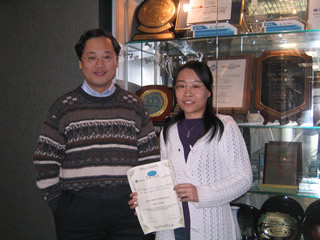Prof. Leung Ho Fung and a Ph.D. student Ms. Lam Ka Man won the Best Paper Award in the 8th Pacific Rim International Workshop on Multi-Agents, PRIMA 2005 for their work entitled “Risk Strategies and Risk Strategy Equilibrium in Agent Interactions Modeled as Normal Repeated 2×2 Risk Games”. This paper introduces some new concepts, which assist the analysis of multi-agent applications and the design of intelligent agents.
The 8th Pacific Rim International Workshop on Multi-Agents held on 28th September 2005 in Malaysia. Participation is by invitation only and is limited to professionals who have made significant contributions to the topics of the workshop.
Paper Abstract:
Many multi-agent interactions, like auctions and negotiations, can be modeled as games. Game theory is a tool to analyze these multi-agent applications as games and to analyze how agents should interact in these applications, which helps design intelligent agents. In many of the existing solutions to these multi-agent applications, the concept of risk is used, but it is not formally defined in game theory. On the other hand, in many games, pure strategy Nash equilibrium does not exist, while mixed or behavioral strategy equilibria are not appropriate, as mixed or behavioral strategies are probabilistic in nature, and it is possible that a low utility results in particular (sub)games. Worse, mixed or behavioral strategies cannot properly model the autonomous nature of agents. Furthermore, trigger strategies for repeated games are based on punishment, which is sometimes not as good as making decisions based on experience. However, making decisions based on past experience is not represented in existing game theory concepts. To solve the problems, we introduce the concept of risk strategies in repeated 2×2 risk games. We find that players can get better payoffs by using risk strategy than using mixed or behavioral strategies in repeated 2×2 risk games. In addition, we find that a game without pure strategy Nash equilibrium can converge to a new type of equilibrium, which we define as risk strategy equilibrium.
